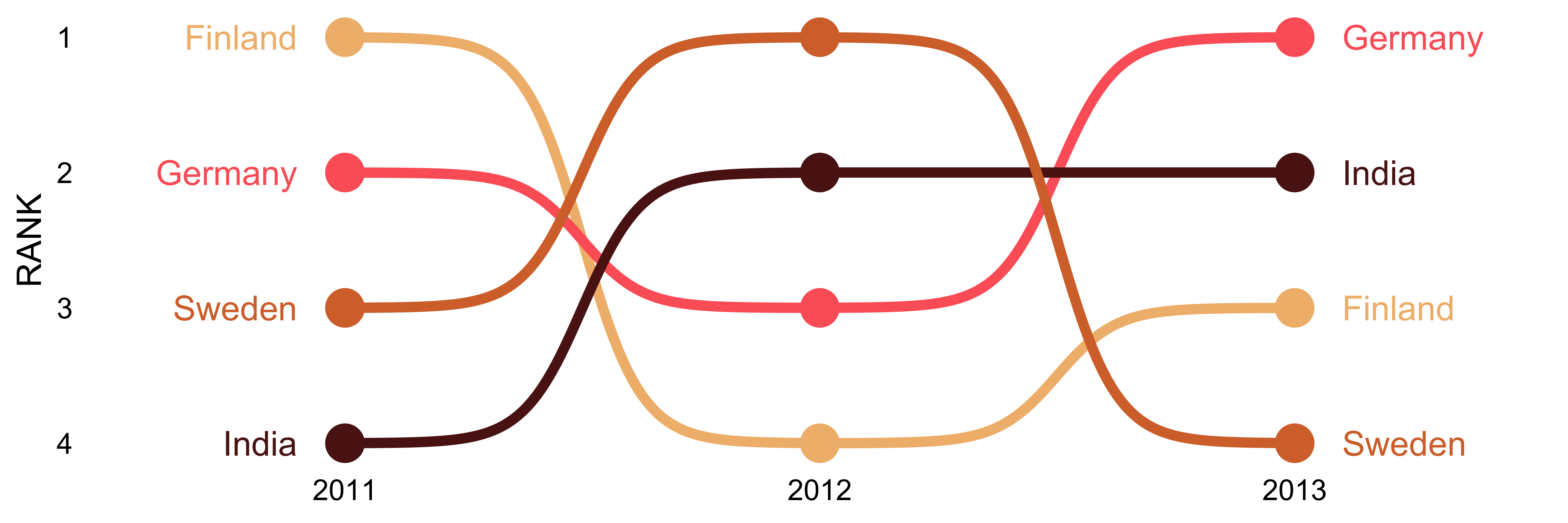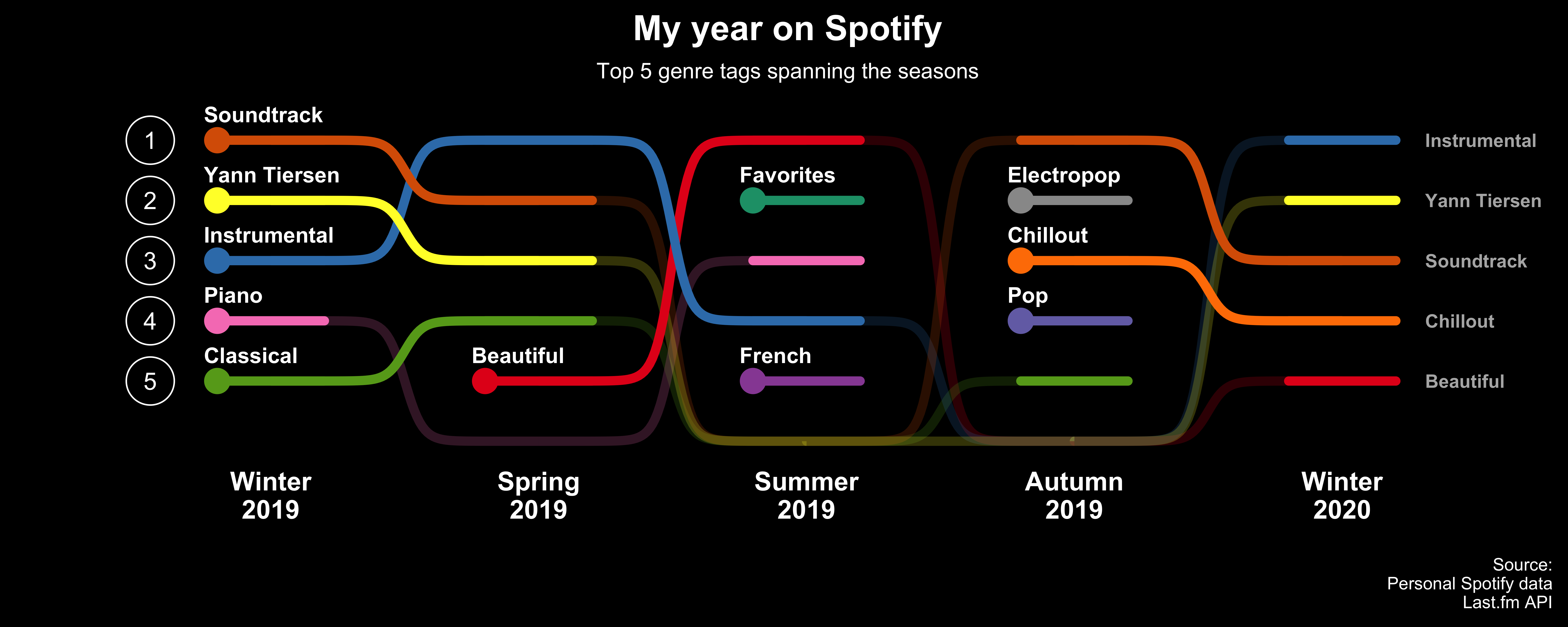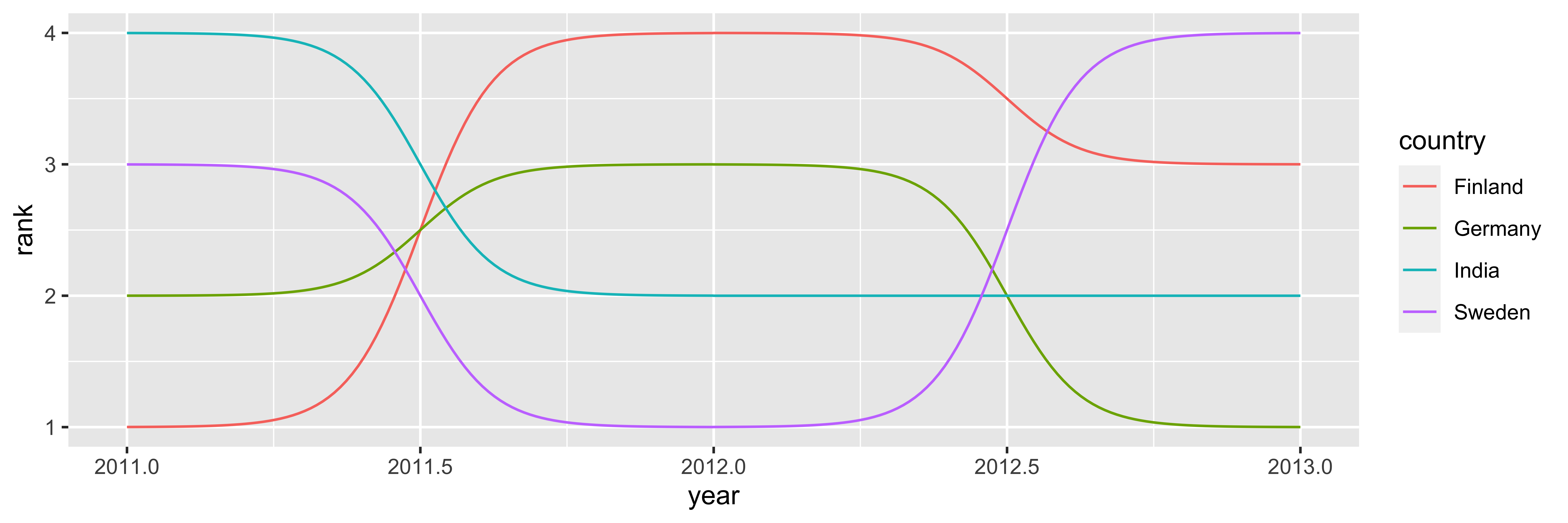Bump Chart and Sigmoid Curves.
ggbump
The R package ggbump creates elegant bump charts in ggplot.Bump charts are good to use to plot ranking over time.
Installation
You can install the released version of ggbump from github with:
devtools::install_github("davidsjoberg/ggbump")
Bump chart Examples
Basic example:

A more advanced example:

Click here for code to the plot above
Flags could be used instead of names:

Click here for code to the plot above
With geom_sigmoid you can make custom sigmoid curves:

Click here for code to the plot above
Tutorial
Prep
Load packages and get some data with rank:
if(!require(pacman)) install.packages("pacman")
library(ggbump)
pacman::p_load(tidyverse, cowplot, wesanderson)
df <- tibble(country = c("India", "India", "India", "Sweden", "Sweden", "Sweden", "Germany", "Germany", "Germany", "Finland", "Finland", "Finland"),
year = c(2011, 2012, 2013, 2011, 2012, 2013, 2011, 2012, 2013, 2011, 2012, 2013),
rank = c(4, 2, 2, 3, 1, 4, 2, 3, 1, 1, 4, 3))
knitr::kable(head(df))
| country | year | rank |
|---|---|---|
| India | 2011 | 4 |
| India | 2012 | 2 |
| India | 2013 | 2 |
| Sweden | 2011 | 3 |
| Sweden | 2012 | 1 |
| Sweden | 2013 | 4 |
Make a bump chart
Most simple use case:
ggplot(df, aes(year, rank, color = country)) +
geom_bump()

Pimp the bump chart!
Improve the bump chart by adding:
- A point for each rank observation.
- Choose a minimal theme, I use
theme_minimal_grid()fromcowplot. - Choose nice colors so it does not look generic ggplot. I use a palette from
wesanderson. - Remove legend and add labels at the start and end of the bumpy ride.
- Reverse the y-axis to get rank 1 at the top.
- Adjust the ‘smoothness’ of the lines by setting
smoothto 8. Higher means less smooth.
ggplot(df, aes(year, rank, color = country)) +
geom_point(size = 7) +
geom_text(data = df %>% filter(year == min(year)),
aes(x = year - .1, label = country), size = 5, hjust = 1) +
geom_text(data = df %>% filter(year == max(year)),
aes(x = year + .1, label = country), size = 5, hjust = 0) +
geom_bump(size = 2, smooth = 8) +
scale_x_continuous(limits = c(2010.6, 2013.4),
breaks = seq(2011, 2013, 1)) +
theme_minimal_grid(font_size = 14, line_size = 0) +
theme(legend.position = "none",
panel.grid.major = element_blank()) +
labs(y = "RANK",
x = NULL) +
scale_y_reverse() +
scale_color_manual(values = wes_palette(n = 4, name = "GrandBudapest1"))

geom_bump with factors
To use geom_bump with factors or character axis you need to prepare the data frame before. You need to prepare one column for the numeric position and one column with the name. If you want to have character/factor on both y and x you need to prepare 4 columns.
# Original df
df <- tibble(season = c("Spring", "Summer", "Autumn", "Winter",
"Spring", "Summer", "Autumn", "Winter",
"Spring", "Summer", "Autumn", "Winter"),
position = c("Gold", "Gold", "Bronze", "Gold",
"Silver", "Bronze", "Gold", "Silver",
"Bronze", "Silver", "Silver", "Bronze"),
player = c(rep("David", 4),
rep("Anna", 4),
rep("Franz", 4)))
# Create factors and numeric columns
df <- df %>%
mutate(season = factor(season,
levels = c("Spring", "Summer", "Autumn", "Winter")),
x = as.numeric(season),
position = factor(position,
levels = c("Gold", "Silver", "Bronze")),
y = as.numeric(position))
# Add manual axis labels to plot
p <- ggplot(df, aes(x, y, color = player)) +
geom_bump(size = 2, smooth = 8, show.legend = F) +
geom_point(size = 5, aes(shape = player)) +
scale_x_continuous(breaks = df$x %>% unique(),
labels = df$season %>% levels()) +
scale_y_reverse(breaks = df$y %>% unique(),
labels = df$position %>% levels())
p

And some nice theme features
p +
theme_minimal_grid(font_size = 14, line_size = 0) +
theme(panel.grid.major = element_blank(),
axis.ticks = element_blank()) +
labs(y = "Medal",
x = "Season",
color = NULL,
shape = NULL) +
scale_color_manual(values = wes_palette(n = 3, name = "IsleofDogs1"))

Feedback
If you find any error or have suggestions for improvements you are more than welcome to contact me :)